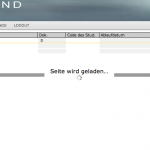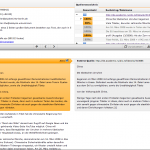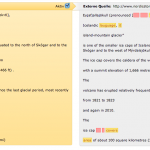Software Profile | Description | Pros & Cons | Report | Usability | Summary | Screenshots | Links
Software Profile
| ID | S13-06 |
| Product | Urkund |
| Company | PrioInfo AB |
| Web-Site | http://www.urkund.com/ |
| Software-Type | Online, can be integrated into Learning Management Systems |
| Pricing | The cost depends on the number of students. |
| Testdate | 2 April 2013 |
Description
Urkund is offered by the Swedish company PrioInfo AB. The costs are not mentioned explicitly on their website, although Google shows a list of their prices as of 2010.
Documents can be uploaded to Urkund in three different ways: They can either be uploaded directly to the website, or uploaded via the university’s Learning Management System (Urkund offers an API for that), or sent in by the students directly to a specific email address for the course. The teacher is notified in all three cases when the results are ready and can read the report on Urkund’s website.
Pros & Cons
Urkund’s plagiarism analysis showed the best results of the entire test 2013, although it only received 73% of the possible points. It found most sources and was able to deal with Hebrew characters and Hebrew sources. It also accepts small ZIP files.
Urkund does not use the chosen language consistently and while a contact was named for Germany, no German-speaking employee was available by telephone. Although Urkund finds many plagiarized passages in small documents, it only finds a smaller number of sources in large documents. This shows that the analysis of long documents e.g. dissertations through Urkund can be problematic.
As with many other systems, Urkund did not find sources from Google Books.
Report
The report view in Urkund is a positive aspect of the system. It offers a side-by-side view and shows detailed information. In comparison to earlier tests, Urkund shows changes that were made to the original text (such as replacing or deleting a few words). Its side-by-side view is the only one in test 2013 that compares the uploaded text to a number of different sources. Other systems only compare the text to one source. There are many elements of the interface that are not easily understandable, although one can still focus on the text parallels identified while ignoring the elements.
Users can choose to exclude certain sources and text passages from the calculation of the overall percentage, a possibility that is offered by a few other systems.
Urkund reports what percent of a text passage was copied from the original source. However, these percentages are often completely unclear, as it is not clear what the basis for the percentage is.
Usability
Overall, Urkund has a positive usability. The report view offers an appealing design and many interesting possibilities. A few negative aspects exists nevertheless: The upload page has an extremely unappealing design and is very difficult to use. Other aspects might confuse users: The term „Search“ is used to describe the page where documents can be uploaded. „Nicht verwendete Quellen“ (English: „sources not used“) are shown in the report view. What exactly these unused sources are is not explained. An email from Urkund clarified that these sources have less than 4% similarity with the uploaded text.
Summary
Urkund provides good search results and a few unique features. However the design and the usability of the upload page still has much room for improvement.
Screenshots
- Windows theme in Urkund
- Report view in Urkund
- Side by side view in Urkund



